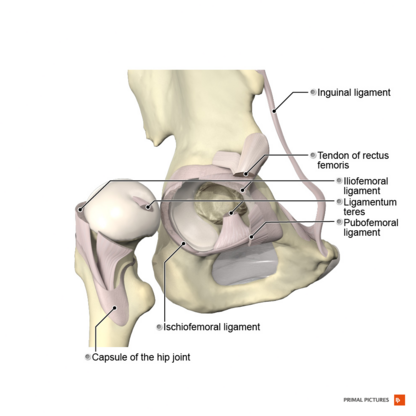Ischiofemoral Ligament: Difference between revisions
Mohit Chand (talk | contribs) No edit summary |
Mohit Chand (talk | contribs) No edit summary |
||
| Line 9: | Line 9: | ||
=== Attachments === | === Attachments === | ||
[[File:Hip joint Primal.png|frameless|416x416px]] | [[File:Hip joint Primal.png|frameless|416x416px]] | ||
The ischiofemoral ligament | . | ||
* The ischiofemoral ligament originates from the ischium at a point below and behind the acetabulum and attaches to the intertrochanteric line of the femur. | |||
* It attaches to the posterior surface of the acetabular rim and acetabular labrum, extending around the circumference of the joint to insert on the anterior aspect of the femur. | |||
== Function == | == Function == | ||
| Line 15: | Line 18: | ||
</ref> | </ref> | ||
It is considered one of the weaker hip ligaments but still contributes significantly to joint stability, excursion, and capacity. | |||
{{#ev:youtube|zyqiRs4MnzA}} | {{#ev:youtube|zyqiRs4MnzA}} | ||
== Clinical Relevance == | == Clinical Relevance == | ||
Injuries to the ischiofemoral ligament can occur in dislocations, leading to lesions of the '''foveal artery''' and potentially resulting in [[Avascular Necrosis Femoral Head|osteonecrosis]] of the femoral head. | Injuries to the ischiofemoral ligament can occur in dislocations, leading to lesions of the '''foveal artery''' and potentially resulting in [[Avascular Necrosis Femoral Head|osteonecrosis]] of the femoral head. The ligament is also associated with conditions like hip joint effusion, fractures, dislocations, and congenital dislocation of the hip, highlighting its clinical relevance in hip pathologies.<ref>Moore, K. L., Dalley, A. F. and Agur, A. M. R. (2013) Clinically Oriented Anatomy. Clinically Oriented Anatomy 7th edn.: Wolters Kluwer Health/Lippincott Williams & Wilkins. | ||
Standring, S. (2016) Gray's Anatomy: The Anatomical Basis of Clinical Practice. Gray's Anatomy Series 41st edn.: Elsevier Limited.</ref> | |||
== References == | == References == | ||
Revision as of 16:20, 21 March 2024
Original Editor - Mohit Chand
Top Contributors - Mohit Chand
Introduction[edit | edit source]
The hip joint is reinforced by three primary fibrous capsular ligaments, including the ischiofemoral ligament, which plays a crucial role in stabilizing the joint. [1]This ligament, along with the iliofemoral and pubofemoral ligaments, contributes to the overall stability and function of the hip joint.
Attachments[edit | edit source]
- The ischiofemoral ligament originates from the ischium at a point below and behind the acetabulum and attaches to the intertrochanteric line of the femur.
- It attaches to the posterior surface of the acetabular rim and acetabular labrum, extending around the circumference of the joint to insert on the anterior aspect of the femur.
Function[edit | edit source]
The ischiofemoral ligament restricts internal rotation of the hip joint, particularly in relation to hip flexion angles. Studies have shown that this ligament, along with the iliofemoral ligament, plays a significant role in preventing excessive internal hip rotation and maintaining joint stability.[2]
It is considered one of the weaker hip ligaments but still contributes significantly to joint stability, excursion, and capacity.
Clinical Relevance[edit | edit source]
Injuries to the ischiofemoral ligament can occur in dislocations, leading to lesions of the foveal artery and potentially resulting in osteonecrosis of the femoral head. The ligament is also associated with conditions like hip joint effusion, fractures, dislocations, and congenital dislocation of the hip, highlighting its clinical relevance in hip pathologies.[3]
References[edit | edit source]
- ↑ Ng, K. C. G., Jeffers, J. R. T., & Beaulé, P. E. (2019). Hip Joint Capsular Anatomy, Mechanics, and Surgical Management. The Journal of bone and joint surgery. American volume, 101(23), 2141–2151.
- ↑ Baba K, Chiba D, Mori Y, Kuwahara Y, Kogure A, Sugaya T, Kamata K, Oizumi I, Suzuki T, Kurishima H, Hamada S, Itoi E, Aizawa T. Impacts of external rotators and the ischiofemoral ligament on preventing excessive internal hip rotation: a cadaveric study. J Orthop Surg Res. 2022 Jan 4;17(1):4. doi: 10.1186/s13018-021-02873-w. PMID: 34983573; PMCID: PMC8725321.
- ↑ Moore, K. L., Dalley, A. F. and Agur, A. M. R. (2013) Clinically Oriented Anatomy. Clinically Oriented Anatomy 7th edn.: Wolters Kluwer Health/Lippincott Williams & Wilkins. Standring, S. (2016) Gray's Anatomy: The Anatomical Basis of Clinical Practice. Gray's Anatomy Series 41st edn.: Elsevier Limited.







